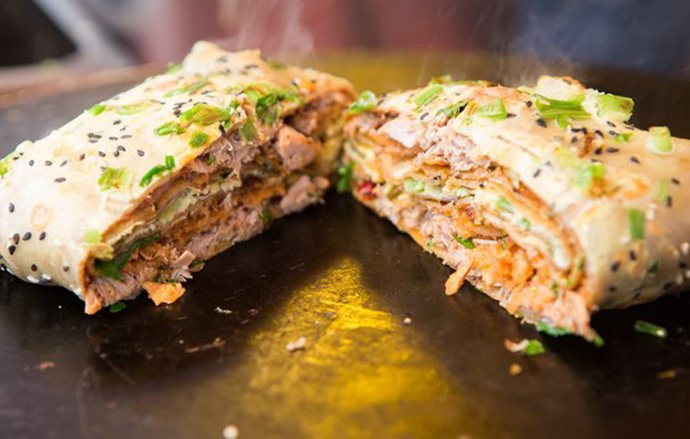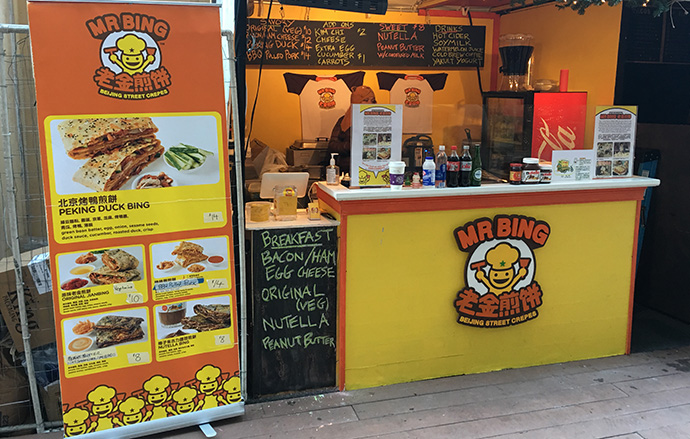Mr. Bing’s Brian Goldberg on Chinese Street Food and NYC’s Best Dumplings
Maggie Borden
Maggie BordenMarch 07, 2016

“Bing in Chinese means anything flat, round, and edible. So a bing can be a pancake, a pizza, a taco,” says Brian Goldberg, the man behind Chinese street-crêpe business Mr. Bing, which made its American debut last winter at the Urbanspace holiday market in Times Square. Goldberg will bring his crêpe-maker and trademark Beijing bites to our upcoming JBF Greens New Zealand Wine Fair, determined to convert local diners to the cult of this addictive, age-old Chinese comfort food.
Goldberg, a born-and-bred New Yorker, first encountered jianbing (or “bings,” colloquially) while studying abroad in Beijing as an undergraduate. The mobile street food, typically sold from carts on the backs of bicycles, is made from a green bean- and white-flour batter mixed with Chinese herbs and spices; coated in egg, scallions, and sesame seeds; and filled with a variety of ingredients, from sauces to vegetables to Kalbi beef. Goldberg quickly fell in love, but it wasn’t until years later in graduate school at Columbia that he came up with a business plan to bring bings to the U.S. After over a decade living and working in China, Goldberg made the leap and opened up Mr. Bing in Hong Kong. We sat down with the crêpe-king in advance of the Greens event to talk about why he moved back home, what makes bings so irresistible, and his go-to spots for dumplings and more in New York City.
--
JBF: What inspired you to bring your business to the U.S.?
Brian Goldberg: I’d been working abroad in finance and journalism for 13 years, and I opened the first Mr. Bing four years ago in Hong Kong, where I was living at the time. The climate there is very hot and humid and the culture there is very southern Chinese, which is very different, taste-wise, from northern China (where bings originated). The people that were most enthusiastic about our food were Mainland Chinese from northern China that grew up with this, and foreigners from America, the U.K., Australia, South Africa, South Asia, etc. Sales were also much better in the colder weather of the winter, so for those and a lot of other reasons, I felt like it was time to move back home. Family was a big part of it—I’m an only child, my parents are getting older, I’d been away a long time, and I missed New York. And every time I came back to the States, whether it was New York, or San Francisco, or L.A., I would see all these innovative food businesses sprouting up, and I felt that the environment here would be more supportive of what we were doing. People are looking for new food concepts, and more and more Chinese students are living in America, and going to school here. So many signs pointed to more demand for what we were doing, and when I showed people videos and the brand they all said, “that would do really well in New York.” So for all those reasons I decided to move back and start the business here.
JBF: How does your menu in New York City differ from what you offered in Hong Kong?
BG: Our Hong Kong menu started with the same base of the classic Beijing bing: green bean batter crêpe coated with scrambled eggs, sesame seeds, scallions, hoisin sauce, crispy chile paste, cilantro, and crunchy wontons. We also had the Peking duck bing there—it was our most popular item in Hong Kong, and ended up being the top-seller at the Times Square pop-up, too. One thing we probably won’t bring over is the char siu bing, which is filled with a Hong Kong–style barbecued pork. We offered sweet bings in Hong Kong as well: peanut butter with condensed milk, kaya with coconut, and Nutella. We did have that at the Times Square pop-up—when some people see crêpes, especially Europeans, all they want is Nutella. But that doesn’t really get at the heart of what this product is. We really want to teach people what a traditional Chinese bing is. So we’ll have sweet options, but it’s not really the focus of Mr. Bing.
JBF: Are there other items you’re thinking of including?
BG: We introduced some dumplings at the pop-up, which proved very popular—they’re easy to eat, and everyone knows dumplings. We’re introducing a totally new food here, and so we want to offer something a little more familiar to pull customers in.

JBF: What’s your favorite traditional bing? And what’s your favorite on the Mr. Bing menu?
BG: When I was a student in China in 1998, my go-to was the original with no cilantro, double egg, and extra-spicy. Every morning, I’d wake up and have a bing while studying for my morning Chinese character exam. I could get it right outside of our dormitory—literally, there was a guy right outside, who was always there. I had that at least once every day, and sometimes at night, after drinks. It’s a pretty good late-night food.
That’s still my go-to, on our menu, as well. The Peking duck was my original favorite, but I think I’ve had so many of them now that I’ve just had to move on to something new. Right now if I’m going to go for some meat, I’m loving a Kalbi beef filling.
JBF: What are some of your favorite spots for Chinese food in the city?
BG: Well, I just moved back, so I’m really in the process of re-exploring Chinese and Asian food in New York. I love RedFarm and Decoy—the Katz’s pastrami egg roll is great, the Peking duck is great, and I like the atmosphere there. I like going to Shun Lee—I appreciate the restaurant’s history and the Upper West Side Chinese-American-Jewish food experience. For dumplings, right now I really like Mimi Cheng’s Dumplings. It’s a very clean experience that’s being made freshly in front of you, they have some creative ingredients along with the traditional ones, and the atmosphere inside is a Hamptons/Montauk beach-y sort of vibe. I also went to the Boba Guys recently, which is like a healthy version of bubble tea. They’re really focused on the ingredients that are going in it, and sourcing them locally, to make bubble tea as clean an experience as possible. Doron Wong who has Yunnan BBQ and Northern Tiger, he makes something called a shaobing, which is quite different from jianbing, it’s a much thicker wrap and it’s the Taiwanese version of what we make, but it’s also delicious. In Chinatown, Lam Zhou Handmade Noodles—it’s a hole-in-the-wall, but the dumplings are very good, and the hand-cut noodles are great.
JBF: What are you making for the Greens event?
BG: We’re just going to keep it simple and authentic, and make the classic Beijing bing. I want people to know the real thing, and how it’s made. Plus, it’s vegetarian, so it has a broader appeal.
JBF: What’s next for Mr. Bing? Where do you see the business in 5 years?
BG: The next step is getting our first permanent kiosk open. We’re in negotiations with a couple of food hall landlords to get our first small brick-and-mortar locations and prove the kiosk model. And if the first one goes well, we have opportunities at other food halls, so hopefully there will be four or five small Mr. Bing kiosks in different corners of the city. Then we can start thinking about how this might work in the suburban shopping mall environment, or in a smaller U.S. city. It could also be on college campuses, and even sports stadiums or airports. And then you have a catering business around it, where you’re doing corporate events, special events, music festivals, concerts—that helps get the word out, it’s fun, it’s interactive—you teach people about bings, they can even try making one themselves, so it’s like a little traveling road show. It’s about execution. I think the food is good, the brand is strong, no one’s doing what we’re doing yet—it just comes down to how you run the business.
Try a bing in person at the JBF Greens New Zealand Wine Fair event on March 10.
--
Maggie Borden is assistant editor at the James Beard Foundation. Find her on Twitter and Instagram.




-57 web.jpg)


